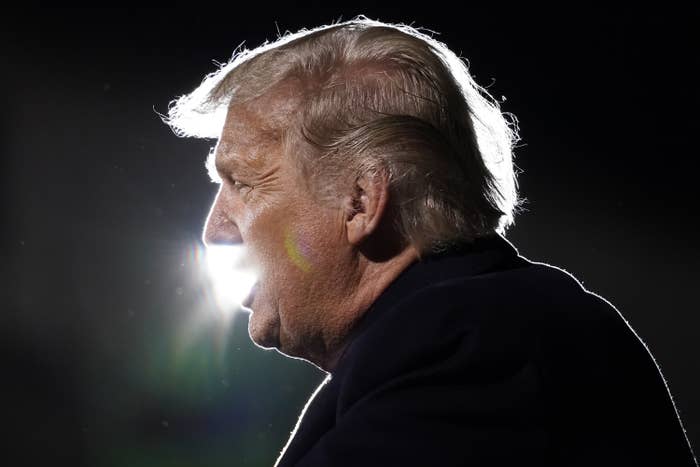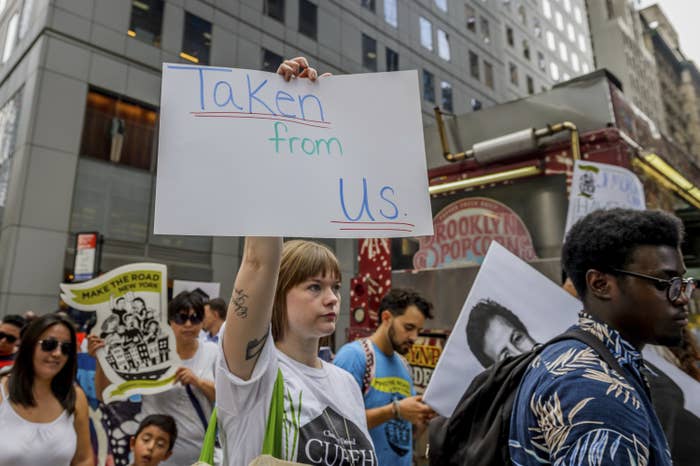USA CRIMES AGAINST HUMANITY
As Trump Cuts Refugee Admissions, US Officers Wonder: “Is This Who We Are?”“I think Americans are missing that this is a part of our history and who we are and speaks to our values," one refugee officer said.
Posted on October 6, 2020

Alex Brandon / AP
President Donald Trump speaks at a campaign rally at Duluth International Airport in Minnesota, Sept. 30, 2020.
At a campaign rally in Minnesota last week, President Donald Trump railed against former vice president Joe Biden, declaring that the Democratic candidate would “inundate” the state with a “flood” of refugees. Trump said Biden would allow refugees to come in “from the most dangerous places of the world” and that he would turn the state into a “refugee camp.”
That evening, the Trump administration announced the latest step in its gutting of the refugee system: a proposed cap for the maximum number of refugees that can enter the US in the next year to 15,000, the fewest since the government began the program in 1980.
The drastic cut in admissions is the latest in a series of moves by the Trump administration that have decimated the country’s refugee program, which is designed to take in people fleeing dangerous conditions, and forced US organizations that help welcome refugees to lay off staffers and close offices.
US refugee officers who spoke to BuzzFeed News said the Trump administration’s efforts at cutting the refugee program down to its very core was not only personally difficult for them to witness, but that it would have a lasting impact. The four officers, who spoke on the condition of anonymity, wondered whether Americans had simply been too overwhelmed by the news to recognize the significance of the administration’s efforts.
“It seems like Americans at large are just unable to comprehend the policy changes across all humanitarian programs that have all but stopped our programs,” said one refugee officer. “Even those who may care have fatigue at keeping up. I have that fatigue, so I’m sure everyday Americans certainly would.”
One veteran refugee officer said that for years the task of evaluating the claims of refugees seeking to come to the US had been traumatic. “You can’t have human beings tell you the worst things that have ever happened to them — unimaginable things — and go away unchanged,” the officer said.

Erik Mcgregor / Sipa USA via AP
Hundreds of immigrants and allies in New York City protest outside the JPMorgan Chase offices, calling out its complicity in Trump's anti-immigrant agenda, Aug. 2, 2017.
But the officer felt like they were following the law and protecting those who were vulnerable by offering them a shot at safety in the US.
“Now I’m not sure anymore. I look at the systematic dismantling of the refugee program in America and I have to ask myself: Is this, what’s happening now, who we really are?” the officer said. “People who are fearful and shut the door on others in desperate need? Was I wrong this whole time? I don’t know. I hope not. But now I just don’t know.”
In 2018, the Trump administration capped the number of refugees at 30,000; in 2019, it set the figure at 18,000 — far fewer than the 110,000 allowed in the final year of the Obama administration. The cap does not necessarily mean immigration officials will actually admit that many refugees, and it instead acts as a ceiling. The official determination for refugees will be submitted by the administration after a consultation period with Congress.
The Trump administration has argued over the last several years that it has been involved in protecting refugees in various ways, including funding efforts to provide assistance to people as close to their homes as possible before they are able to go back, noting that the US had given “more than $9 billion in humanitarian assistance in Fiscal Year 2019 and nearly $70 billion in humanitarian assistance over the past decade.”
The United Nations reported in June that nearly 80 million people were displaced at the end of last year.
The State Department noted that the decision on the cap was made in part to “prioritize the safety and well-being of Americans, especially in light of the ongoing COVID-19 pandemic.” Refugee admissions had been on hold earlier in the year due to the pandemic before restarting in the summer. The proposed refugee cap includes special slots for Iraqis who helped the US government, refugees from Central America, and others from Hong Kong, Cuba, and Venezuela.
US officers assess the eligibility of refugees abroad to enter the country, a process that includes security checks and interviews. One refugee officer said there were fears the program would be scrapped altogether by the Trump administration.
“We have gotten so used to baseless attacks on the refugee program that many of us are grateful that at least we can offer refuge to up to 15,000 rather than zero,” the officer said. “But it’s sad. Under previous administrations, 15,000 would have been a fraction of the number of refugees resettled.”
Even as the refugee program has shrunk, certain groups are feeling the impact more than others. Researchers at the Migration Policy Institute found that Muslim admissions through the refugee program had dropped 87% from 2016 to last year. Trump had called for a ban on all Muslims to enter the US when he was a candidate for office in 2015.
One refugee officer said they actively hope they don’t get assigned cases of individuals seeking protection who are from the Middle East.
“It’s heartbreaking to be asked what’s next for my case, when will I have an answer, and I know that people I interviewed in 2018 are no nearer to approval,” the officer said. “I think Americans are missing that this is a part of our history and who we are and speaks to our values.”
MORE ON IMMIGRATION
A Judge Has Temporarily Blocked Trump From Raising Fees For Asylum-Seekers And Citizens
A Judge Has Temporarily Blocked Trump From Raising Fees For Asylum-Seekers And Citizens
Hamed Aleaziz · Sept. 30, 2020
Hamed Aleaziz · Sept. 23, 2020
Hamed Aleaziz is a reporter for BuzzFeed News and is based in San Francisco.

No comments:
Post a Comment